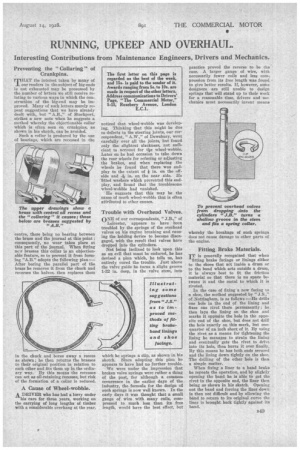RUNNING, UPKEEP AND OVERHAUL.
Page 75

If you've noticed an error in this article please click here to report it so we can fix it.
Interesting Contributions from Maintenance Engineers, Drivers and Mechanics.
Preventing the " Collaring " of Crankpins.
IIIIAT the interest taken by many of our readers in the subject of big-ends is not exhausted may be presumed by the number of letters we still receive relating to various ways in which the construction of the big-end may be improved. Many of such letters merely repeat suggestions that we have already dealt with, but " A.B.," of Stockport, strikes a new note when he suggests a method whereby the objectionable collar which is often seen on crankpins, as shown in his sketch, can be hvoided.
Such a collar is produced by the use of bearings, which are recessed in the
centre, there being no bearing between the brass and the journal at this point ; consequently, no wear takes place at this part of the journal. When fitting new brasses this collar is an objectionable feature, so to prevent it from forming "A.B." adopts the following plan :— After boring the parallel part of the brass he removes it from the chuck and reverses the halves, then replaces them
in the chuck and bores away a recess as shown; he then returns the brasses to their original position in relation to each other and fits them up in the ordinary way. By this means the recesses can act as oil-retaining recesses, but risk of the formation of a collar is reduced.
A Cause of Wheel-wobble.
A DRIVER who has had a lorry under his care for three years, working on the carrying of long lengths of timber with a considerable overhang at the rear,
noticed that wheel-wobble was developing. Thinking that this might be due to defects in the steering joints, our correspondent, " A.W.," of Dewsbury, went carefully over all the joints, but found only the slightest slackness, not sufficient to account for tip wheel-wobble. Later on he had occasion to take down the rear wheels for refacing or adjusting the brakes, and when replacing the wheels he found that there was endplay to the extent of I in. on the offside and -A in. on the near side. He 'fitted washers which prevented this endplay, and found that the troublesome wheel-wobble had vanished.
He suggests that this may be the cause of much wheel-wobble that is often attributed to other causes.
Trouble with Overhead Valves.
ONE of our correspondents, " J.B.," of Leicester, appears to have been troubled by the springs of the overhead valves on his engine breaking and causing the holding device to become disengaged, with the result that valves have dropped into the cylinders.
Not being inclined to look upon this as an evil that must be endured, he has devised a plan which, he tells us, has entirely cured the trouble. Just above the valve guide he turns a slight groove 1-32 in. deep, in the valve stem, into which he springs a clip, as shown in his sketch. Since adopting this plan he appears to have had no further trouble.
We were under the impression that broken valve springs were rather a thing of the past, for although a common occurrence in the earlier days of the industry, the formula for the design of such springs is now well known. In the early days it was thought that a small gauge of wire with many coils, compressed to much less than its free length, would have the best effect, but
practice proved the reverse to be the case. A larger gauge of wire, with necessarily fewer coils and less coin, pression from its free length was found to give better results. If, however, some designers are still unable to design springs that will stand up to their work for a reasonable time, drivers and mechanics must necessarily invent means whereby the breakage of such springs does not cause damage to other parts of the engine.
Fitting Brake Materials.
IT is generally recognized that when
fitting brake facings or linings either to the shoes that act inside a drum or to the band which acts outside a drum, it is always best to fit the friction material so that there is no space between it and the metal to which it is riveted.
In the ease of fixing a new facing to a shoe, the method suggested by "
of Nottingham, is as follows :—He drills one hole in the end of the lining and fixes one rivet there permanently ; he then lays the lining on the shoe and marks it opposite the hole in the opposite end of the shoe, but does not drill the hole exactly on this mark, but onequarter of an inch short of it. By using the rivet as a means for tightening the lining he manages to strain the lining and eventually gets the rivet to drive into its hole, then burrs it over finally. By this means he has both ends secured and the lining down tightly on the shoe. The drilling of the other hole is then a simple matter. •
When fixing a liner to a band brake he repeats the operation, and by slightly opening the band he is able to get the rivet in the opposite end, the liner then being as shown in his sketch. Opening out the band and forcing the liner down is then not difficult and by allowing the band to return to its original curve the liner is brought back tightly against its band.




















































































































